In 2020, DTU Aqua is once again leading a project in search of knowledge on one of the world’s most iconic species: the Atlantic bluefin tuna. Follow the updates from the project on this page.
In collaboration with Danish fishermen, a team led by Kim Aarestrup and Brian MacKenzie, DTU Aqua are tagging bluefins again this year, after successful projects in 2017, 2018 and 2019.
Atlantic bluefins are the largest of their kind, reaching lengths of well over 3m and weighing up to 700 kg. Bluefin tuna can be found in a large part of the Atlantic Ocean. The species has two known spawning areas in the Mediterranean Sea and the Gulf of Mexico.
Historically, bluefins were part of an important fishery in the Skagerrak-Kattegat area, before disappearing from the area almost 60 years ago. Now, the giants have returned to Scandinavian waters.
The project therefore aims at shedding some light on where these fish come from, and where they are going, in an effort to better manage this highly vulnerable species.
Updates by the researchers from DTU Aqua about tuna tagging 2020
......
2019 - Six tuna tagged in spite of slow start
|
9 September 2019
The weather out at sea has unfortunately worsened overnight. After consultation with local anglers who know the sea conditions quite well, we decided to go out and stay slightly more East than our usual location, where the waves were supposed to be slightly smaller. The weather was rather rough on the way out, especially just North of Skagen where the two seas meet.
Fortunately, the weather was a bit better out where we were fishing. After a slow start, our luck turned and we were able to tag 6 fish with electronic tags. We feel that this is an incredible result, considering the conditions that both the anglers and the tagging team were dealing with.
The weather forecast unfortunately is not “tuna-tagging-friendly” for the next weeks, so we’ve decided to leave wonderful Skagen and go home. We are keeping a window open for the rest of September in case the weather clears up and allows us to go out for a few days to tag a few more tunas with the remaining electronic tags.
|
Tuna tagging again Sunday
|
|
8 September 2019
After far too many days on land the weather was finally good enough to go out on the sea again. There were still some waves on the way out, but it slowed down a little during the day, though not as much as the tagging team had hoped ...
We didn't have too much luck on our first fishing spot, so after a few hours we moved further north and got more lucky. There was clearly not as many tuna to be seen today than the other days. Despite a strong effort from over 40 boats, we only managed to tag three at 228 cm, 244 cm and 257 cm. But still the day is approved. Tomorrow we hope it gets wilder.
|
A short day Sunday with two tagged tuna
|
|
1 September 2019
Tagging has been suspended the last few days due to bad weather out at sea. After discussing with local experts, we saw a small window of opportunity this morning, and decided to brave the weather with a dozen boats.
Despite the fact that we only fished for about 2 or 3 hours, our fleet successfully landed 2 bluefins which were tagged with 10-year acoustic tags. The fish were 252 and 258cm. We were also gifted with a frenzy of feeding and jumping tunas nearby.
All in all, a very successful day out there despite poor weather conditions. The fleet and the tagging team are keeping their fingers crossed for better weather to come soon...
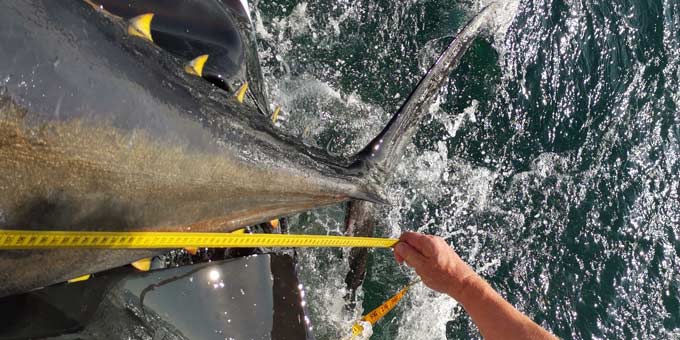
Two bluefin tuna tagged and measured Sunday - measuring 252 and 258 cm respectively. Photo: Kim Birnie-Gauvin, DTU Aqua.
|
Another sunny day Wednesday
|
|
28 August 2019
Another fine day at the Skagerrak tuna tagging office.
Sunny calm weather let us tag 6 tunas, ranging in size from 225-243 cm with electronic tags. 4 tunas were tagged with PSAT tags and 2 were tagged with acoustic tags. All tunas got a conventional tag. .
We will look at the weather and wave forecast tonight and decide whether we can go tomorrow or not.
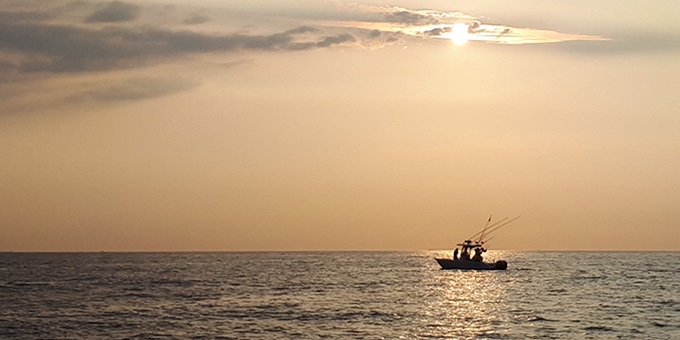
Boats going out from Skagen for bluefin tuna.
|
Four tuna tagged on day 4
|
|
27 August 2019
Time flies when you are in good company. Nice weather again today. Just 20 minutes into the fishing a couple of tuna took baites. But it was barely as good as the other days. We ended up with four tagged tuna today between 231 and 254 cm.
Tomorrow, we try a new spot further west, where many tuna should have been observed in the last few days. Come back and read about how it went..
|
Another great day
|
|
26 August 2019
Another day of magnificent weather on the Skagerrak. We left the harbor at 7.00 with 60 boats.
Less tuna activity today - at least in the surface. But they were there. A total of 8 tuna were tagged - measuring from 228 to 260 cm.
All the boats are fishing within a short radius of the tagging boat and since everyone has AIS mounted we can easily follow the course of the battle. We still have more tags, so Tuesday we'll be back on the sea.
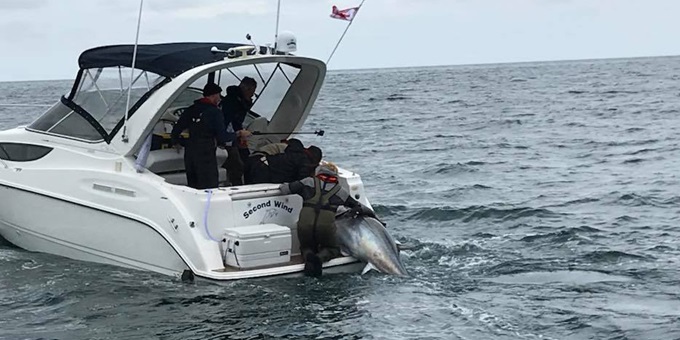
The bluefin tuna are transferred to the researchers' tagging boat, where they are measured and tagged. The picture here is from last year's tagging. Photo: Nikolaj Kolding Pedersen.
|
17 tuna tagged and released Sunday
|
|
25 August 2019
The late summer turned out from its best side today. Great weather and virtually no waves out there.
The tuna were also cooperative, in fact so much that two of them took two baits at the same time. Unfortunately one of the tunas did not survive. It is now reported to the Tuna Commission and falls under their research quota.
We got a total of 17 bluefin tuna, from 231 cm to 262 cm. The proportion of fish brought to the boat was also really good, so overall a busy day at the office in the Scandinavian Bluefin Marathon. But when the office os on the Skagerrak in nice weather, it's not that bad. Monday? - Yes we'll give it another go.
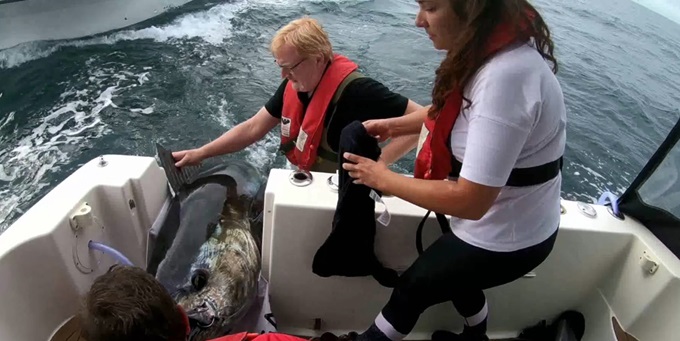
Researchers from DTU Aqua measuring and tagging a bluefin tuna in the 2018 tagging project. Photo: Kim Birnie-Gauvin, DTU Aqua
|
Three tuna tagged the first day
|
|
24 August 2019
Off we went. Many months of preparation culminated today for both fishermen and scientists as we started the 2019 Scandinavian Bluefin Marathon.
The wind and the waves were supposed to settle during Saturday, so we took the chance and went out late in the morning for a half-day tagging and refining of gear and procedures.
We were more than 70 boats going out to Skagerrak from Skagen. The weather conditions were relatively difficult (at least the tagging team could feel it ...). Nevertheless, we managed to tag three large beautiful tuna, with the largest of approx. 260 cm. Tomorrow it looks like another day at sea. We'll keep you posted.
|
Watch film from the tuna tagging 2018
Facts on the various tags for bluefin tuna
|
|
The tagging team uses various types of tags, each designed to provide different measurements which together will allow them to better describe and understand the bluefins’ migratory movements (and life history). Some measurements include behavior, speed, temperature, depth, lighting, and when a fish is captured.
Floy tags from ICCAT (International Commission for the Conservation of Atlantic Tunas): A floy tag is a small plastic tag with a unique number. This tag is provided by ICCAT, and should be returned to ICCAT when found; a small reward is given when floy tags are returned. This type of tag allows ICCAT (and the researchers) to obtain information on catch, and also on growth because the tag provides a beginning and an endpoint (when the tag is put on, and when the fish is captured).
Pop-up satellite archival tags (PSATs): A PSAT tag stores information about the temperature, depth and light conditions that the fish is moving through. The tag is programmed to free itself (or pop-up) from the fish and rise to the surface at a pre-determined date. Once at the surface, the tag transmits the stored data using satellites, after which the researchers also receive the data. The data can then be compared with bathymetry and other oceanic data, and the most likely path of movement can be determined. In this way, the researchers can trace back where a fish has been while the tag was on.
Acoustic tags. An acoustic tag emits a coded acoustic signal which is captured by a global system of “listening” stations, organized under an organization called Ocean Tracking Network (OTN). Listening stations are found across the globe, but areas of particular importance for this project are the east coast of North America, the coasts of the United Kingdom and Ireland, and the Mediterranean. These tags will emit a signal for the next 10 years. Given that tunas can live up to 40 years, such a tag gives a great opportunity to investigate whether a fish repeats certain patterns through part of its lifetime.
Accelerometer tags: These tags are a brand new development, and are built to sit directly on the tuna for a very short time. During that short time, the tag will measure the fish’s swimming behavior in 3 dimension very accurately. In this way, the researchers can describe in detail what the fish has been doing at sea, including swimming and feeding behavior.
Overall, the different tags will provide important knowledge about the various aspects of tuna behavior, including where they go and what they do. These methods (also known as telemetry) as necessary to understand what, where and why the bluefins behave the way they do.
This entire setup, including the participation from hundreds of fishermen, requires a lot of effort. To make the most of it, and as a means of obtaining the best data to understand the fish’s behavior, a sufficient number of tags must be deployed. The tunas are handled as gently as possible, and the tagging is done in a such a way that it is as short as it can possibly be. Any doubt from the tagging crew as to the state of the fish, and the fish is not tagged and is released immediately.
How are the fish doing?
It is of course impossible to tell exactly how every fish is doing after it has been released. But we can get a very strong indication from the PSAT tags. These tags are programmed to release from the fish and pop-up to the surface if it is at the same depth for 2 days. This means that in the event that a fish dies, the researchers would get a notice within 2 days. So far, none of the 8 PSAT tags deployed this year have sent a notice, which should be interpreted as a good sign, and that the tunas are doing well.
|
Updates by the researchers from DTU Aqua about tuna tagging 2018
Successful project
|
|
2- 6 September 2018
The last days have been overwhelmingly busy, so here’s a brief recap.
2 September 2018: 13 fish tagged.
3 September 2018: the team was off to prepare for the upcoming days.
4 September 2018: 11 fish tagged.
5 September 2018: 17 fish tagged.
6 September 2018: 2 fish tagged.
In total, the project has successfully tagged 91 bluefin tunas in Skagerrak, including 11 with PSAT tags, 2 with acoustic tags and 2 with accelerometer tags.
While the project is a great success, the team was unable to deploy all of their tags. On 7 September 2018, our goal was to deploy 4 accelerometer tags, but only 2 were deployed. An additional 8 acoustic tags have not been deployed owing to the large size of the fish (these tags are only deployed on fish smaller than 225 cm). Nonetheless, the team is thankful to the 400 or so volunteers who participated in the project and made it the success that it was.
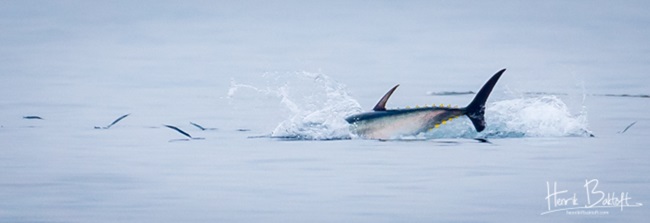
Blue fina tuna jumping in Danish waters.
|
The behavior of tuna is best elucidated by researchers using various telemetry methods
|
|
1 September 2018
Today’s weather was amicable, and about 40 boats joined the tagging team at sea. After a long day, a total of 10 bluefins were tagged and safely released (length of 241 to 265cm). The tagging crew was on a new boat today, with a new setup, but all procedures operated smoothly. The crew is constantly working out the finer details to operate as quickly, and with the least impact on the fish. Jumping tunas were once again spotted all over, even as close as 2 nautical miles north of Grenen.
Here, you can read more about the various tags that the researchers are using to better understand the tunas’ behavior.
|
Great support for bluefin tuna
|
|
30 August 2018
Today, we were once again out to tag tuna in Skagerrak. Approx. 40 boats from Denmark, Sweden and Germany participated – fantastic support. It is evident that all the participating fishermen are united by their great passion and dedication to the conservation of tuna. Today was a relatively short day at sea, but 7 tunas were tagged and released before we headed home. The tunas ranged from 216 to 260cm in length. Quite a few bluefins were out feeding at the surface of the water, but not quite as many as yesterday.
There will be no fishing on Friday due to bad weather, but the fishing will restart Saturday.
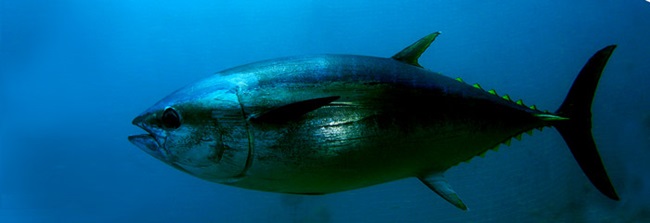
Blue fina tuna
|
Bluefin tuna – 12 tagged and released Wednesday
|
|
29 August 2018
Wednesday was another day with a strong participation of boats on the water. Despite a long and hard day at sea Tuesday, everyone was ready to help make the tuna tagging research project 2018 a success. Again today, within about 20 minutes, the first tuna took the bait. In total, 12 bluefins were tagged and released, ranging between 233 and 265 cm in length (estimated weight of 225 to 330 kg). Another 9 took the bait but escaped before tagging.
The tunas are hauled on board the tagging boat, where a large hose of seawater is used to keep the tuna well ventilated. The tag is then applied, and a small piece of fin is obtained to perform genetic analysis for research. The fish is then measured before being released safely back into the water. The whole process takes a few minutes.
Today’s weather was with us, and the bluefins gave everyone an entertaining show of their raw power throughout the day by chasing saury at the surface. A good day at the "office".
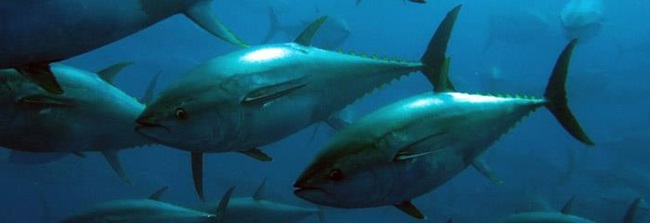
Blue fina tuna
|
World class – and nothing less
|
|
28 August 2018
There was a strong representation of Danish, Swedish and German boats out today in Skagerrak to catch and help the team tag giant bluefin tunas.
Today, beating all the odds, a total of 15 individuals were tagged and released and there were an additional 10 bites. The first bite occurred after only 7 minutes of fishing.
The tagged fish ranged from 221 to 260 cm (equaling approximately 191 and 315 kg), and are now roaming free. Here’s to hoping for a similar day tomorrow.
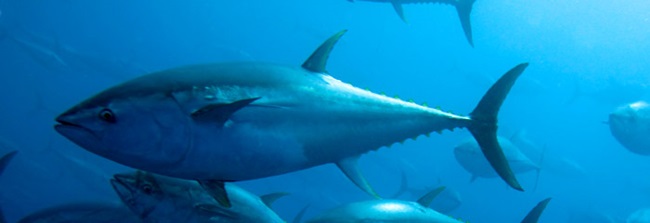
Bluefina tuna.
|
Four Atlantic bluefin tunas tagged in Scandinavian waters
|
|
26 August 2018
Yesterday morning, despite somewhat rough conditions, a crew of approximately 20 boats went out with DTU Aqua’s tagging crew to catch and tag bluefin tunas.
It took less than 20 minutes for the first tuna to take the bait.
The day’s results: a lot of observations, and a total of 8 bites
Four bluefins tagged and released safely, 3 escaped during the fight, and one unfortunately did not survive the fight. This last tuna has been reported to ICCAT and falls under their research quota.
The four tagged bluefin tunas ranged from 240 to 265cm in length, representing a weight of approximately 237 to 334kg.
What an exceptional first day for the Scandinavian Bluefin Marathon team.
Stay tuned for more over the next few days.
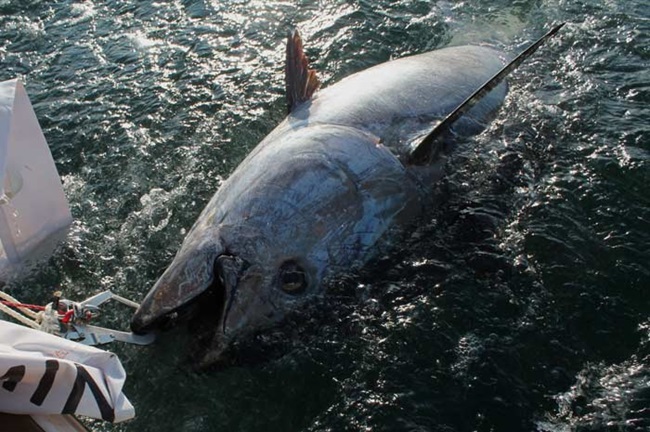
Bluefin tuna caught in Danish waters - 2018. Copyright Kim Birnie-Gauvin.
|
Watch film from the tagging project in 2017
Af Kim Birnie-Gauvin, DTU Aqua. National Institute of Aquatic Resources.